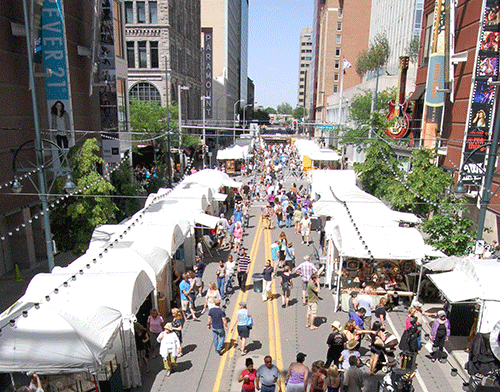Tips for Art Festivals and Shows

Patrons shopping at the Downtown Denver Arts Festival. Photo credit: Jason Hussong at jasonstravels.com.
Summer is around the corner and with that the season for art fairs, festivals, and shows. If you’re new to the circuit, here are tips to keep in mind while attending these events:
1. Do Your Research. Investigate local festivals before applying for a spot. Points to keep in mind while you’re scoping the event include:
• Market Audience: Is there entertainment that is drawing patrons away from the artwork? How many people are actively buying and carrying their purchases? Is the event located in an area of high income or tourism? Are the vendors dressed casually or formally?
• Art Quality and Price Range: Are the other works on display equal to your artistic caliber? If the festival has low quality crafts or lower price points compared to your work, you may not sell well because buyers will be interested in bargains rather than quality. Shows with a broad range of mediums and prices tend to attract art savvy patrons.
• Traffic Volume: Is there a high turnout? Don’t let low traffic be a deterrent if people are actively enjoying and purchasing art.
• Costs: How much will it cost to exhibit? Are there juried fees? Booth fees? Are display tables provided or is the artist responsible for bringing their own? Where do others rent or buy equipment? Have you included these costs in your sale price calculations?
• Artists: How are others displaying their products? How happy or busy are the artists? Stop by booths on the last day to briefly ask how well they did—especially those with works similar to yours. Most creatives will gladly share information and let you know which events are worth your time. Keep in mind that artists may be too busy to chat, so take a business card to follow up later or offer to wine and dine them that evening or weekend.
2. Work Your Way Up. Even high-end professional artists started small.
• Get your feet wet by participating in local fairs or farmer’s markets, where you can learn from beginner mistakes. Use trial-and-error to find out where and which of your art sells best. You may realize that certain festivals do not fit your style, demographic, or price range.
• Some shows and fairs are difficult to get into.It may take years to network your way in or figure out what juried shows look for.
• Don’t give up! Your work may be rejected from one festival but accepted at another.
• You’ll learn the most at smaller juried shows rather than craft fairs.
• Attend events that you have scouted or other artists recommend. Well-intentioned buyers may suggest fairs that are a waste of time and money because they’re not looking at it from a business owner’s perspective.
• Even if you are not selling at a specific fair, go anyway and network. It is important to get exposure at events within your niche.
3. Merchandising and Sales. What does the customer see?
• Presentation is everything. Set up your booth to look like a professional gallery. Don’t overcrowd. Be selective and show pieces that will draw people in. Allow room for customers to walk around comfortably.
• Always display new work as well as recent award-winning work.
• Step into the crowd and walk toward your booth from different angles. Establish the line-of-sight areas where patrons first see your table and hang your best work there.
• Depending on your medium, creating art live and in-person draw crowds. It is also a good way to obtain on-the-spot and future commissions.
• Always take photos of your booth layout and displays. Larger fairs or juried shows require images of your booth set up.
• For festivals that are two or more days, rearrange your art and displays. It will look like work sold, draw attention to other pieces, and create a sense of urgency for buyers.
• Practice! Make a list of what you need. Take an afternoon to pack your inventory, transport it to a park, set up your merchandise on a table, tear it down, load it into the car, go home and unpack. How much time does it take? Are you bringing too little or too many items? Do you need to edit your supplies list?
• Smile and share your story! Briefly describe your process and why or how a piece came together. Patrons are more likely to buy work that resonates with them, especially if there is a story they can share with others.
• Accept credit cards. Square, Inc. (squareup.com) is free with a nominal processing fee.
• Keep track of your expenses. You may make a lot in sales, but is it worth it if you break even after travel, food, and hotel? Consider increasing sale price calculations to assist in covering all your expenses.
• Price tags and labels need to be large and typed. If customers repeatedly ask how much a piece costs, consider adjusting its location on the display or increasing the font size.
4. Equipment. Are you prepared?
• Invest in a high-quality tent and panels. Make sure the canopy is made of a heavy material and that you have substantial weights (i.e. concrete blocks or sand bags) or stakes to drive into the ground. The last thing you want is for a gust to turn your tent into a kite and knock over nearby booths.
• Bring various sizes bags and packaging to wrap sold art. Focus on clean and effective rather than expensive wrapping.
• Make sure you invent a quick and safe system to transport your work. You want it to arrive at the show “gallery ready” and not broken or damaged.
5. Extra Tips. Because you never know.
• Collect a mailing list. Gather contact information to keep your followers updated with new works and shows. Use a guest book or collect business cards for drawings.
• Recruit one or two friends or family members to help. Make sure only one person remains behind the table and allow no food inside the booth. This will discourage volunteers from being too absorbed in conversation to notice buyers and allows you to network or take breaks.
• Listen to comments! Regulars will become familiar with your work and their insight will help create a more effective display.
• If you are returning to a fair, set up in the same area. Collectors will look for you there.
For more information on festivals and venues, visit the Denver Arts & Venues calendar at artsandvenuesdenver.com/calendar.
Category: ARTrepreneurship





